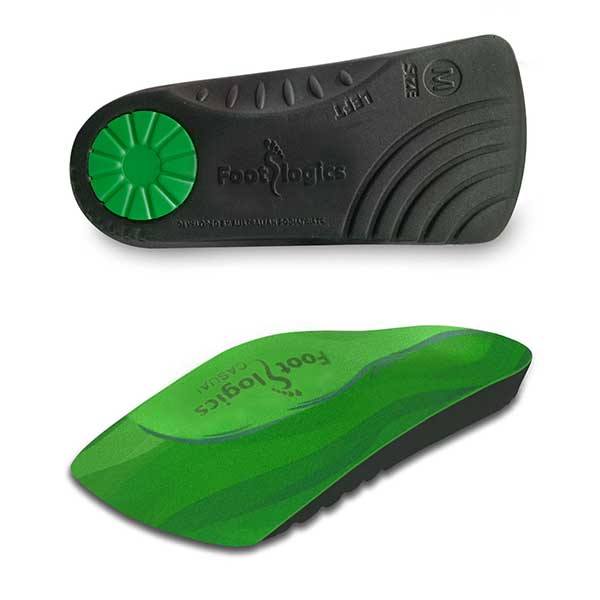Free Shipping On All Orders Over $75
Free Shipping on all orders over $75 Australia Wide
Free Shipping On All Orders Over $75
Free Shipping on all orders over $75 Australia Wide

Over-pronation, or fallen arches, means the foot and ankle tend to roll inwards and the arch collapses with weight-bearing. This is a quite a destructive position for the foot to function in and may cause a wide variety of foot, leg and lower back conditions.
When sitting, an over-pronating foot appears quite normal, i.e. showing a normal arch with room under the underside of the foot. The moment you get up and put weight on your feet the situation changes: the arches lower and the ankle slightly turns inwards. When you walk or run more weight is placed on the feet compared to standing and over-pronation will become more evident. When walking barefoot on tiles or timber floors over-pronation is more visible, compared to walking on carpet or grass.
It is important to note that pronation is not wrong or bad for you. In fact, our feet need to pronate and supinate to achieve proper gait. Pronation (rolling inwards) absorbs shock and supination (rolling outwards) propels our feet forward. It is our body’s natural shock-absorbing mechanism. The problem is over-pronation i.e. the pronation movement goes too deep and lasts for too long, which hinders the foot from recovering and supinating. With every step, excess pronation impedes your natural walking pattern, causing an imbalance in the body and consequent excessive wear and tear in joints, muscles and ligaments. Some common complaints associated with over-pronation include:
Generally fallen arches are a condition inherited from one or both parents. In addition, age, obesity, and pregnancy cause our arches to collapse. Being in a job that requires long hours of standing and/or walking (e.g. teaching, retail, hospitality, building etc) contributes to this condition, especially when standing on hard surfaces like concrete floors. Last, but not least unsupportive footwear makes our feet roll in more than they should.
Flat feet and fallen arches can be treated effectively by wearing an orthotic insert in your shoes. Orthotics can be custom-made and prescribed by your foot specialist (podiatrist), or you can use a so called pre-made foot orthotic. Most people do not require expensive custom-made orthotics to combat excess pronation, unless they have a specific medical foot condition.
Footlogics orthotic insoles were developed to correct excess pronation, thereby providing sustainable, long-lasting pain relief to many aches and pains in a natural way. Footlogics Comfort, Casual and Sports are products which promote excellent biomechanical control of the foot.
It is very common and totally normal for your shoes to wear out faster on the outside than the inside. The reason for this is very simple: your hips are wider apart than your gait (i.e. where you place your feet). This means that during walking the legs are slightly angled towards the center. The first part of the shoe to touch the ground is therefore the outside of the shoe, never the inside.
This causes uneven wear at the bottom of the shoes and it is often mistaken by people as “walking on the outside of my feet”.
This couldn’t be further from the truth. No person walks on the outside of their feet. The foot will strike on the outside for less than a second and consequently it will start to roll inwards to gain full contact with the ground.
What happens next is either
1) the foot stays flat and straight on the ground preparing itself for propulsion (= normal gait)
2) the foot continues to roll inward and the arches flatten (= excess pronation)
So both people with a normal gait as well as those who over-pronate may display excessive wear on the outside of their shoes, which actually has no significant meaning.
Supinators are people who have a condition called a “Pes Cavus” or hollow foot. It is the opposite of Pes Planus (flat foot) and it means the foot is very stiff, showing a high and rigid arch. During walking there’s no natural pronation- supination motion, the foot simply stays rigid (supinated) at all times.
Less than 5% of the population suffers from this condition. Some of these people may show uneven wear on their shoes.
People with a Pes Cavus condition require a soft cushioning footbed to provide them with shock-absorption. For example the Footlogics Sensi can be used for supinators as it provides excellent cushioning.
For people with over-pronation Footlogics Comfort, Casual or Sports are recommended.
NOTE: If pain persist we recommend you consult a health professional for appropriate diagnosis and treatment. Visit the Australian Podiatrists Association to find your local podiatrist.

Array
(
[0] => 6023
[1] => 6017
[2] => 6018
[3] => 6019
[4] => 5981
)


Array
(
[0] => 6016
[1] => 6010
[2] => 6011
[3] => 6012
[4] => 6263
[5] => 6262
[6] => 5981
)


Array
(
[0] => 6072
[1] => 6070
[2] => 6069
[3] => 6068
[4] => 5981
)

Follow Along On Instagram